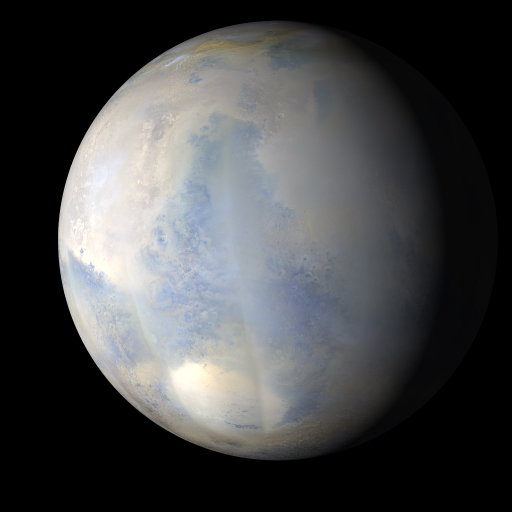
MRO MARCI Weather Report for the week of
|
 CLICK to play Quicktime Movie (9.2 MB) NASA/JPL/Malin Space Science Systems |
Martian Weather Between 19 November 2007 and 25 November 2007:
This is our first in a planned series of weekly Mars weather reports from the Mars Reconnaissance Orbiter (MRO)
Mars Color Imager (MARCI) team. Under nominal MRO operating conditions, the MARCI acquires a global view of the
red planet and its weather patterns every day. Please click and play the Quicktime movie (.mov file) to
see how the weather on Mars changed over the past week.
At this time, only a couple weeks remain for the northern winter and southern summer seasons, as the
equinox— and the start of a new Mars year—will occur
on 9 December 2007. The small southern perennial polar cap (also known as the ‘residual cap’)
has begun to disappear from view as the long polar night approaches. In the northern hemisphere, the seasonal
polar cap, composed mostly of frozen carbon dioxide (dry ice), has reached its greatest equatorial extent, extending
as far south as about 55° North latitude. The large temperature contrasts at the edge of the receding northern
cap help to generate large local dust storms that are similar in shape and form to terrestrial low-pressure storm systems.
Such martian storms can persist for up to three martian days (sols). Last week, these storms were observed moving eastward
at 10 to 20 meters per second (22 to 44 miles per hour). Other local dust storms occurred sporadically over northern
Amazonis and at southern mid-latitudes. Water ice clouds (bluish-white in the movie) were seen over some
of the Tharsis volcanoes and near the edge of the northern seasonal polar cap.
Earlier Mars Weather Reports are available HERE.
About the Quicktime Movie:
The movie (a .mov file that you can click and play, above)
was generated from images obtained last week by the Mars Color Imager (MARCI) onboard the
Mars Reconnaissance Orbiter (MRO). A total of about 273 MARCI images, taken in three of the camera’s seven color filter
bands (420, 550, and 600 nanometer wavelengths), were map projected and mosaiced together to produce seven false-color daily
global maps. These maps were then projected onto a sphere with north at the top and east to the right and
with the mid-afternoon vantage point of an observer in the orbital plane (the imaginary plane that the planet
draws out as it circles the Sun).
Black areas in the movie are the result of data drops or high angle roll maneuvers by the spacecraft that limit
the camera’s view of the planet. Equally-spaced blurry areas that run from south-to-north (bottom-to-top) result
from the high off-nadir viewing geometry, a product of the spacecraft’s low-orbit, 250 km x 316 km (155 miles x 196 miles).
The movie is rendered at a lower resolution than the intrinsic 1–2 km nadir resolution that the MARCI provides, so that it
is practical to view and share via the Internet. The small white circles on these images of Mars indicate the
locations of the two Mars Exploration Rovers, Opportunity (on Meridiani Planum) and Spirit (in Gusev Crater). Other locations
on Mars referenced in the weather report can be found by referring to the map below. Note that the still image of Mars depicted
at the top of this page is a single frame from the Quicktime movie. This single image is from the week covered by the current
weather report and the Quicktime movie.
|
Reference Map — Martian Place Names Commonly Mentioned in Mars Weather Reports
NASA/JPL/Malin Space Science Systems |
Citation and Credit
The image(s) and caption are value-added products. MSSS personnel processed the images
and wrote the caption information. While the image(s) are in the Public Domain,
NASA/JPL/MSSS requests that you credit the source of the image(s). Re-use of the
caption text without credit is plagiarism.
Please give the proper credit for use of the image(s) and/or caption.
Image Credit:
NASA/JPL/Malin Space Science Systems
—or—
NASA/JPL/MSSS
To cite the image(s) and caption information in a paper or report:
Malin, M. C., B. A. Cantor, J. A. Lougen and K. S. Edgett (2007), MRO MARCI Weather Report for the week of
19 November 2007 – 25 November 2007,
Malin Space Science Systems Captioned Image Release, MSSS-4,
http://www.msss.com/msss_images/2007/11/29/.
Malin Space Science Systems (MSSS) built and operates the Mars Reconnaissance Orbiter (MRO) Mars Color Imager (MARCI) and Context Camera (CTX). MSSS also built and operated the Mars Global Surveyor (MGS) Mars Orbiter Camera (MOC). In addition, MSSS built the Mars Odyssey (ODY) Thermal Emission Imaging Spectrometer (THEMIS) Visible (VIS) camera subsystem, which shares optics with the thermal infrared instrument and is operated at Arizona State University (ASU). MSSS also built the Mars Descent Imager (MARDI) cameras for the Mars Polar Lander and Phoenix Mars lander missions, and the MARCI onboard the Mars Climate Orbiter. Currently, the company is building cameras for the 2008 Lunar Reconnaissance Orbiter, 2009 Mars Science Laboratory rover and the 2011 Juno mission to Jupiter.
 Malin Space Science Systems, Inc., San Diego, California, U.S.A.
Malin Space Science Systems, Inc., San Diego, California, U.S.A.